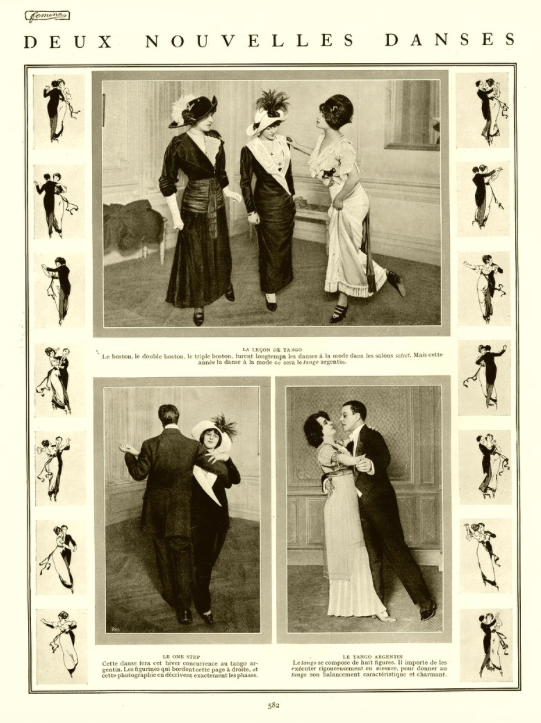Woman teaching tango to women, Paris, 1911

Ray Batchelor writes:
This is a page of the Magazine “Femina” November 1911 reproduced on the website “Une Histoire du Tango” created by Dominique Lescarret and was originally published in the French magazine “Femina” in November 1911.
The text there reads:
Premier article évoquant le Tango : 1er novembre 1911 N°259
En fait, il ne s’agit que d’une simple page, sans autre commentaire, et signalant l’arrivée de deux nouvelles danses.
“Le Boston, le double boston, le triple boston furent longtemps les danses à la mode dans les salons select. mais cette année la danse à la mode ce sera le Tango Argentin.”
“Le One Step : cette danse fera cet hiver concurrence au tango argentin. Les figurines qui bordent cette page à droite, et cette photographie, en décrivent exactement les phases.”
“Le Tango Argentin : le tango se compose de huit figures. Il importe de les exécuter rigoureusement en mesure, pour donner au tango son balancement caractéristique et charmant.
N.D.A. Plusieurs points intéressants dans cette publication, et concernant la danse : d’abord on constate que l’arrivée du Boston est antérieure à celle du tango à Paris. Comme chacun sait, les danseurs, passant d’une danse à l’autre, emmènent avec eux les techniques qu’ils maîtrisent déjà. Nous verrons à la page ” Développement du style ” comment ces danses, Boston, One Step et quelques autres, vont ainsi profondément modifier le style du tango lors de ce passage à Paris. Notons également, que sur une des photos (celle de gauche) le couple est en ” système croisé “. On ne peut en tirer de conclusion générale, la photo étant posée, mais le système existe déjà dans les danses folkloriques et, comme nous le verrons plus loin dans la Maxixe, dès lors que la cavalière est de dos par rapport au cavalier. Autre point très important et qui confortera l’appellation concernant le tango, la notion de “balancement”, qui dans d’autres descriptions et d’autres danses sera dénommée sous des vocables évoquant les navires : “chaloupée” ; “tanguer” ; etc… Il est fortement improbable, comme nous l’étudions à la page ” origine du mot tango ” qu’il y ait relation directe avec la genèse du mot, mais concernant son acceptation, la théorie peut paraitre plausible.
Which Google Translates as:
First article about the Tango: 1st November 1911 # 259
In fact, there is only a single page, without comment, and signaling the arrival of two new dances.
“The Boston double boston, boston three were long fashionable dances in select rooms. But this year the dance fashionable will be the Argentine Tango.”
“The One Step: this dance competition this winter will tango figurines that line this page to the right, and this photograph, describe exactly in phases..”
“The Argentine Tango: Tango consists of eight figures it is important to carry out rigorously able to give to the tango its distinctive and charming swing..
N.e.s. Several interesting points in this publication, and for the dance: first there is the arrival of Boston is earlier than tango in Paris. As everyone knows, the dancers from a dance to another, take with them the skills they have already mastered. We will see to the “style development” how these dances, Boston, One Step and others, and will profoundly change the style of tango during this visit to Paris. Note also, that on one of the pictures (the left) the couple is “cross-system”. One can not draw a general conclusion, the picture being asked, but the system already exists in the folk dances and, as we shall see in the Maxixe, since the rider is back with respect to the rider. Another very important point which will consolidate the label on the tango, the concept of “swing” which in other descriptions and other dances will be referred to as of the words evoking ships “swaying”; “Pitch”; etc … It is highly unlikely, as we are looking to the “origin of the word tango” that there is direct relationship with the genesis of the word, but for its acceptance, the theory may seem plausible.
See also image 0000071, http://image.queertangobook.org/a-woman-teaching-women-1912-en-paris-gente-de-rang-ova-a-la-academia-de-tango/ where the source gave 1912 as the date.
As I wrote there:
I find this interesting because it shows women supporting each other and aquiring tango skills – albeit that in this image, one of the women may have been being paid.
In this image there appears to be a man teaching the women too.
Image URL: http://www.histoire-tango.fr/histoire%20danse%20tango/Femina-copie.htm
Out of copyright